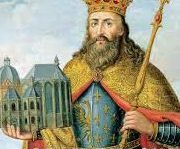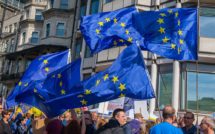
 This is part of our special feature on The Crisis of European Integration.
This is part of our special feature on The Crisis of European Integration.
Johannes Fried’s Charlemagne (translated by Peter Lewis) clocks in at almost 700 pages. A work this size reminds one of the historical novels of James Clavell; the casual observer might heft it and think, perhaps here are found facts and detailed scrutiny of the life and deeds of the ruler described in my secondary school history book as “The Father of Europe.” Acknowledging its length and scope, Fried begins his work on this note, however: “The following book is not a novel, but is a work of fiction all the same – a fiction based on this author’s visualization of Charlemagne” (vii). This is a study of historical construction and reconstruction: how the authors (and patrons) of the contemporary sources shaped their narratives, and how we must fill in the gaps to satisfy modern historiography. Throughout, Fried emphasizes how little is, in fact, known about Charlemagne and how the creation of the emperor’s distinct image of warrior king and saintly ruler was consciously fashioned in the historical record from the start.
Charlemagne is useful for the student revising the era or for the scholar who wants to (re)familiarize him or herself with the era and the accomplishments of the renowned Carolingian. Fried fashions his study from the start as contextual reconstruction of the era in which Charlemagne was born, grew up, reigned, and died. Fried draws the reader chronologically through Charlemagne’s life and work – summed up after hundreds of pages in three words: “Power and prayer” (515). Eight chapters cover the principle eras and themes of his life: boyhood; the Frankish empire in the days of Charlemagne’s predecessors; Charlemagne the warrior king and his military exploits; power structure and courtiers; Charlemagne as domestic administrator; the royal court and its physical and intellectual character; Charlemagne’s imperial ambitions; and finally ‘Imperator Augustus.’ This last chapter examines Charlemagne as emperor, his sense of secular and spiritual responsibility, and the succession (with hints of the atmosphere of Louis the Pious’s reign in contrast to his father’s directives and personality). The epilogue considers the transition of Charlemagne from historical person to folkloric character, the shaping of his image by historians such as Einhard and Nithard in the generation or two after the emperor’s death, the use and abuse of his image by subsequent modern nationalistic historians and politicians, and a brief discussion of the current scholarly image.
The idea of how Carolingian history was recorded – and what wasn’t recorded – intrigues Fried the most throughout this work. He weaves throughout the narrative of each chapter how the contemporary sources commemorate key moments, and how several of the major surviving sources shape the remembrance of notable events. One case study examined by Fried is Charlemagne’s coronation in 800. The sources provide different accounts of the event; to be fair, as Fried notes, there are no immediate contemporary accounts of the coronation, so the scene was recreated much later (419-428). What is important for the historical record of this event is how the moment of the coronation represents in a single, culminating event Charlemagne’s character. The traditional image is one of Charlemagne popping in to church to pray on Christmas day, minding his own business, when the pope quickly nipped up behind him and whacked the imperial crown on his head. Resigned to the new headgear and what it symbolized, dutiful in his responsibility, Charlemagne resolutely took up the mantle and burden of office. Einhard notes, had Charlemagne known what was going to happen that day, he’d’ve never gone to church (Vita Caroli, 28). That’s how I was taught this scene in secondary school and unlearned it as a post-grad, and it’s what I’ve had to unteach my own undergraduates. As Fried points out, of course, there was so much preparation and consideration for Charlemagne in taking on the imperial title that it was an event months if not years in the making. Einhard’s scene illustrates instead how the coronation commemorates in a brief but memorable sketch, Charlemagne’s character rather than a moment that epitomizes a series of events long in the making. The intricacies of political science was not the immediate focus of Carolingian historians, chroniclers, or poets, but Charlemagne’s spiritual patronage and his duty as a ruler to protect the Church, was.
Two themes are at play over the course of Charlemagne. First, is the idea of the conscious shaping of the historical record, not only what the contemporary texts commemorate, but also what they exclude. Throughout, Fried notes what we have not got. For example, there are no facts or details about Charlemagne’s childhood or youth; we know concretely only a few specific details about his activities and the names of only a handful of men who comprised his court. There is no indication at any stage of his life of what he was like personally or in private, what he thought, what he loved, if he felt he was loved (515). To be fair, such emotional and personal issues wouldn’t have been the top priority of the chronicler or of the ruler, who may well have directed the content of, for example, the Royal Frankish Annals (149). As Fried notes, the important legacy of Charlemagne’s reign is his support of the intellectual culture at his court and its subsequent consequences (220ff; epilogue 554). This includes the conscious shaping of memory. The discussion of how sources such as the RFA (139-40) and Godescalc gospels (136) may have been vetted and revised to shape the historical record complement Fried’s support of multidisciplinary methodology such as archaeology (400ff.) to reconstruct the historical record. Other examples remind us of just how much we lack in terms of evidence from the world of Charlemagne’s reign; examples include long gone the physical buildings of Carolingian many residences and palaces (348), the contents of the palace library (340), and even a lack of contemporary images of Charlemagne himself aside from coins (342). We depend instead on the descriptions recorded in poems, inventories, or brief passages in biography.
A second theme that runs throughout the work is the Charlemagne as a case study to exemplify the effects of globalization on a single state. Fried notes that studies of global impact focuses on groups of people rather than individual characters (for example, studying the migrations of tribes in the early Middle Ages). Here is where the impact of the epilogue elevates this ‘fictional account’ of Charlemagne from a survey that reconstructs the era and context of Charlemagne’s life and deeds to one that examines the impact of an individual on global political, social, and economic networks. To set the scene of Charlemagne’s youth, Fried describes the boundaries of the Carolingian empire, that is, the limits of Frankish territories, their frontier marches, territories won by battle, and communication with neighboring cultures and states, the papacy and Lombards, Byzantines, Arabs, Northmen. It’s the basics that we learned in school when we learned about how Charlemagne ‘unified’ Europe. But, Fried asks, what did the Carolingians really know of the outside world? He discusses at some length how, before Charlemagne became king through to the early years of his reign, the Carolingians were fairly parochial – what they knew of places and people beyond their borders was as superficial and stereotyped as the modern image of Charlemagne himself as is, for example, a sainted warrior king or the great unifier of Germany. The Carolingians had no curiosity of or perception of the world beyond their borders (134), a lack attributable to contemporary communication (or lack thereof) and a limited world-view. They had only a vague idea of their own spatial location and geography within their territory let alone that other cultures and civilizations might be organized differently or fought differently or worshipped differently than the Franks. It was really towards the end of the eighth century, when Charlemagne took the initiative and responsibilities to himself as emperor, Fried argues, that they became more socially aware of their place amongst their neighbors. In the years leading up to the end of the century, Charles and his advisors were embroiled in a number of affairs with allies and enemies beyond their borders. Driven by fears of and signs of end times, Charles became more aware of obligations towards neighboring states, and there was an increase in diplomatic activity between, for example, the Carolingians and the Arabs, the Byzantines, and the Papacy (400-410). The Carolingians became more carefully aware of other cultures, if only to consider their own duties and responsibilities towards these places in terms of spiritual care and political protection. Certainly it would be anachronistic to describe the Carolingians in the same terms as one might apply to the interconnectivity of modern trade and political alliances, and Fried does not make such comparisons here. Instead, he argues that investigating and reconstructing Carolingian activity and policy with their neighbors is a relevant to understanding not only the contemporary era of Charlemagne, but also the relevance of his influence and achievement in the modern era – especially on a world currently shake up by political, economic, and cultural contrast and clash between east and west. Study of Charlemagne’s activities on the international scene requires as much critical investigation of the sources as does understanding how and why the contemporary source material shaped its commemoration of events and character. On understanding Carolingian networks, Fried emphasizes the need for multi-disciplinary studies. Pirenne’s seminal argument on the relationship between Charlemagne, the Arab states, and the economy of western Europe may have been superseded (especially by archaeological study), Fried notes, but Pirenne’s methodology remains important in terms of seeing the Carolingians as having developed a global awareness (550-51). Where sources are lacking, multi-disciplinary methodology provides the tools to reconstruct the record, as Fried has done to establish of the context of Charlemagne’s life and activities.
What does Charlemagne and his era symbolism for us now, if not for academic study, but also outside of the classroom? Charlemagne is, if he’s thought of at all, these days a “bland symbol of Europe” (548). Avoid the “Father of Europe” symbolism, argues Fried – focus on the emperor’s intellectual and cultural achievements (549-50): they were the result of a gathering of minds and cultures from across Europe at Charlemagne’s court, and they worked to underscore Charlemagne’s reaction to and relationship with neighboring cultures politically, economically, and spiritually. Study of commemoration and memory remains a popular theme in Classical and medieval scholarship, and Fried’s work here provides a thoughtful template on critical reads and reconstruction of individuals who have become overshadowed by what they symbolize. New narratives and re-evaluation of sources and events against the context of globalization may well be the next exciting step in these studies. As Fried notes, Charlemagne looked beyond the narrow physical and intellectual horizons of the world of his youth. What we can take away from a new assessment of this era and its sources is Charlemagne’s increased awareness of interlinking culture and economics. There is much food for thought here in this rich and thoughtful study.
Reviewed by Carey Fleiner, University of Winchester
Charlemagne
by Johannes Fried (translated by Peter Lewis)
Publisher: Harvard University Press
Hardcover / 673 pages / 2016
ISBN: 9780674737396
Published on November 2, 2017.




